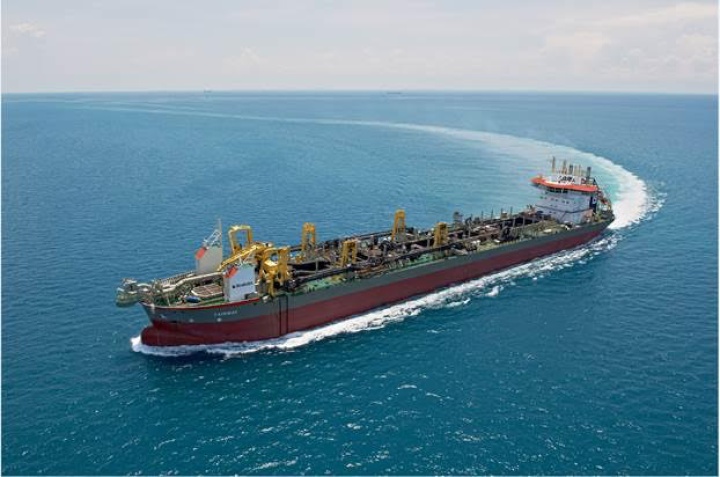Fairway on Its Way to Lyttelton
27 JUNE 2018
Fairway on Its Way to Lyttelton as First Stage of Channel Deepening Nears

One of the world’s largest dredges, the Fairway, is due to arrive in Lyttelton Harbour in August as the Port’s channel deepening project gets underway.
Lyttelton Port Company (LPC) was granted resource consent in March 2018 to dredge the harbour shipping channel to increase its draft.
The 230 metre-long Fairway will collect sand and silt from the seabed of the harbour, as it works to widen the navigation channel by 20 metres and deepen it to allow vessels with a 13.3 metre draft to call at Lyttelton. The first stage of work will see the Fairway lengthen the channel by 2.5km and will take 11 weeks to complete.
The channel deepening, which will allow bigger ships to access the Port, will provide Canterbury’s importers and exporters the best possible and most-cost effective international shipping solutions.
The initial stage of the dredging programme has been awarded to Netherlands-based contractor Royal Boskalis Westminster N.V. – a global operator with more than 100 years’ experience. Built in 1997, the Fairway is one of Boskalis’ 30 trailing suction hopper dredgers.
The Fairway will make its journey from Mumbai, India, after completing its latest project – and make a stop in Singapore for a thorough clean before heading to Lyttelton Harbour. The Cawthron Institute has worked with LPC and Boskalis to develop a biosecurity plan.
In Singapore, it will go into a dry dock to be water blasted and have its antifoul refreshed. The interior spaces will be cleaned and flushed with fresh water. After being inspected, it will sail directly to New Zealand.
Cawthron
Biosecurity Team Leader Oli Floerl says, “LPC has been
very pro-active in making sure this dredge has minimal
biosecurity risk.”
In anticipation of the channel
deepening, LPC has already implemented the largest
environmental monitoring programme ever undertaken for a New
Zealand dredging project. Environment Canterbury is
satisfied that LPC’s plans balance what is best for the
environment, the community and the growing regional
economy.
While the Fairway is hard at work, a plume will
be clearly visible from the dredge, but LPC Environmental
Advisor Jared Pettersson says this is a normal aspect of the
dredging process on the seafloor.
“The environmental
effects of the plume were evaluated during the consent
process. It was found any environmental effects would be
minimal and short-term as the ecosystem is used to naturally
occurring fluctuations in water clarity.
“We have
implemented New Zealand’s most robust real-time water
quality monitoring system that will ensure the proposed
dredging does not result in adverse outcomes for the
environment.”
LPC achieved a mediated outcome with Ngai Tahu in regards to protecting the environmental and cultural value of Whakaraupō and Koukourārata.
As a result, LPC will cease dumping dredge spoil, from a previous consent, at Awaroa/Godley Head, Livingstone Bay, Breeze Bay and Mechanics Bay which are important breeding grounds for kaimoana.
The company will pay Te Rūnanga o Koukourārata and Te Hapū o Ngāti Wheke fisheries enhancement funding that will be used on projects to increase mahinga kai within Koukourārata and Whakaraupō (Lyttelton) harbours. There will be strict environmental limits for dredging and dumping spoil.
LPC Chief Executive Peter Davie has thanked Iwi for the positive and constructive way they approached mediation.
LPC’s Harbour Watch website will provide real-time data as part of the company’s water-quality monitoring project, www.lpcharbourwatch.co.nz.
This video demonstrates how the dredge operates: https://we.tl/17NahmWTQY
·
During the past five years Lyttelton Port Company has made
major investments in infrastructure, enhanced its
high-performing operations and improved market-leading
exporter and importer services and support.
· As
the South Island’s largest container port, Lyttelton
Port’s freight volumes are forecast to more than double in
30 years.
· An international trend in container
shipping towards much bigger vessels is requiring many ports
to deepen channels within their harbours to allow ships with
deeper draft to visit.
· This is very similar to
airports needing to extend their runways to accommodate
bigger passenger jets.
· Currently, most
container ships carry 4,000 twenty-foot equivalent units
(TEUs), but making the channel deeper and wider will allow
new larger vessels to load and offload up to 9,500 TEUs at a
time.
· The Port is vital to the industries that
are the engine of Canterbury’s regional economy -
agriculture, manufacturing, construction, forestry and
fishing. LPC is ready to manage the freight rise from the
$264 million a year increase in agribusiness production
resulting from irrigation projects such as Central Plains
Water.
ends


 Commerce Commission: Commission Concludes Auckland Airport Over-charging By $190 Million
Commerce Commission: Commission Concludes Auckland Airport Over-charging By $190 Million The Future Is Rail: Ferry Decision - Common Sense Prevails
The Future Is Rail: Ferry Decision - Common Sense Prevails Aotearoa Food Rescue Alliance: Grocery Market Reform Must Include Mandatory Food Rescue Partnerships
Aotearoa Food Rescue Alliance: Grocery Market Reform Must Include Mandatory Food Rescue Partnerships Hugh Grant: Zero Trust Security - A Buzzword Or The Ultimate Protection?
Hugh Grant: Zero Trust Security - A Buzzword Or The Ultimate Protection? Bill Bennett: Comcom revisits fibre rules as competition intensifies
Bill Bennett: Comcom revisits fibre rules as competition intensifies Bill Bennett: Download Weekly Extra - InternetNZ disrupted
Bill Bennett: Download Weekly Extra - InternetNZ disrupted



